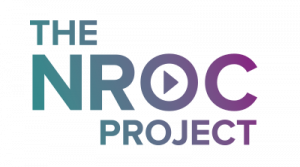Today we welcome the President of the NROC Project, Ahrash Bissell, to discuss accessibility as an opportunity we should all be involved with, rather than a regulatory requirement that we should all worry about. We are excited to see this post from our friends at NROC, who have won a WOW award or have collaborated with several of our WOW winners in the past (such as University of Montana and the Monterey Institute for Technology). As Ahrash discusses, we should aspire to make accessibility an everyday practice, rather than comply because it is simply a requirement. Thank you for a wonderful post!
Enjoy the read and enjoy your day,
– Lindsey Downs, WCET
From the perspective of most educational publishers and technology providers, ‘accessibility’ is a word that conjures thoughts of legal compliance, challenging technical tasks, and additional costs. From the perspective of most students and educators, ‘accessibility’ is a philosophy and an aspiration where students are not arbitrarily excluded from certain learning experiences by dint of their particular learning needs. Regardless of your perspective, there is widespread agreement that finding a way to maximize accessibility is critical for any educational-technology implementation, yet it remains challenging to define expectations for all parties.
Accessibility: Regulatory Burden or Opportunity?
We found that it was both dissatisfying and problematic to think about accessibility requirements as a regulatory burden.
At NROC, we found that it was both dissatisfying and problematic to think about accessibility requirements as a regulatory burden. It was dissatisfying because our aspiration is to support every student, so we felt that we should be able to accommodate every student as part and parcel of our mission: to meet society’s need for high-quality educational opportunities. It was problematic because achieving some compliance standard is not equivalent to having developed an effective learning solution. As we have grappled with these issues over the past few years, we have refined our approach to accessibility and established some core principles to guide our efforts. We make no claim to have originated these ideas, but we think they may be useful to other organizations in a similar place.
Accessibility (Compliance) Is a Practice, Not a Destination
As a sector, educational technology is very much in a state of flux, with new programming approaches, plug-ins, and various other tools and techniques being introduced and incorporated into product-development pipelines all the time.  Accessibility guidelines also continue to evolve, and assistive technologies vary in their behavior and adherence to published standards. The result is that learning applications must comply with multiple expectations, all of which might change at any time and without notice. We found it useful to establish a threshold of ‘reasonable’ compliance (e.g., using the WCAG 2.0 AA standard), but we otherwise incorporate accessibility issues into our standard bug-fixing and support protocols. In other words, accessibility is not a special class of problems, and accessibility improvements are never ‘finished’.
Accessibility guidelines also continue to evolve, and assistive technologies vary in their behavior and adherence to published standards. The result is that learning applications must comply with multiple expectations, all of which might change at any time and without notice. We found it useful to establish a threshold of ‘reasonable’ compliance (e.g., using the WCAG 2.0 AA standard), but we otherwise incorporate accessibility issues into our standard bug-fixing and support protocols. In other words, accessibility is not a special class of problems, and accessibility improvements are never ‘finished’.
Ideally, Accessibility and Efficacy Should be Synonymous
If a student has no problems utilizing a given application, but that application is unable to provide that student with the presumed benefits of its usage, is it really accessible? We don’t think so. We recommend, instead, that the distinctive needs of each user should be explored and defined. We should avoid the natural tendency to design for the middle. In any case, we have had much more productive engagements with the higher education community when we keep the focus on improved outcomes rather than compliance issues.
Embrace a Community-based Approach
It takes time and effort to incorporate people outside of our organization into our agile development processes, but for accessibility issues, such involvement is crucial. We have tried–with some success–to build a community of people and organizations who are able to give us advice, help with testing, and think through emergent challenges. We have had especially productive partnerships with other organizations focused on accessibility in educational technologies, including Benetech, the Inclusive Design Research Center, and CAST.
The Future of Accessibility in Higher Education
 We anticipate that the technical aspects of accessibility compliance will get easier in the future, in large part because digital resources are amenable to automated compliance audits and can even self-correct many deficiencies. However, the technology landscape continues to evolve and new challenges arise daily, so there will always be some gap between the cutting edge of educational-technology applications and their accessibility. More importantly, accessibility is a social compact, not a technical specification, and we have a long way to go where ‘good design’ is synonymous with ‘accessible design’.
We anticipate that the technical aspects of accessibility compliance will get easier in the future, in large part because digital resources are amenable to automated compliance audits and can even self-correct many deficiencies. However, the technology landscape continues to evolve and new challenges arise daily, so there will always be some gap between the cutting edge of educational-technology applications and their accessibility. More importantly, accessibility is a social compact, not a technical specification, and we have a long way to go where ‘good design’ is synonymous with ‘accessible design’.
Accessibility is a social compact, not a technical specification, and we have a long way to go where ‘good design’ is synonymous with ‘accessible design’.
NROC’s Mission
NROC is committed to serving the full diversity of our student population. When we say we want every student to succeed, there is no asterisk excluding some subset of that population. Our long-standing work in open educational resources (OER) is substantially motivated by this concern. Therefore, to meet the needs of individual students, the design and development of our multimedia materials presume that content localization and adaptation are both necessary and desirable. Similarly, we specifically built EdReady–a platform for personalized learning–to make it easier for educators to differentiate instruction among cohorts of students.
We believe that broader adoption of educational technologies for classroom use will reduce the discrepancies in educational outcomes among students. By supporting differentiated instructional strategies, enabling multiple representations of concepts, and integrating more seamlessly with easy-to-deploy assistive tools, educational technologies are likely to be key in eliminating the need to categorize students as ‘enabled’ or ‘disabled’, instead embracing the full diversity of learner preferences and needs in any given setting. We welcome inquiries and participation from anyone interested in these issues. Please contact me or visit NROC.org to get involved.

Ahrash Bissell
President
‘The NROC Project’
Dr. Ahrash Bissell is the president of The NROC Project (NROC). Ahrash has long been interested in academic transitions that too often leave marginalized and otherwise vulnerable students behind. Before joining NROC, he led Creative Commons’ global ccLearn project and served as a STEM-education specialist at Duke University’s Academic Resource Center.

 Accessibility guidelines also continue to evolve, and assistive technologies vary in their behavior and adherence to published standards. The result is that learning applications must comply with multiple expectations, all of which might change at any time and without notice. We found it useful to establish a threshold of ‘reasonable’ compliance (e.g., using the WCAG 2.0 AA standard), but we otherwise incorporate accessibility issues into our standard bug-fixing and support protocols. In other words, accessibility is not a special class of problems, and accessibility improvements are never ‘finished’.
Accessibility guidelines also continue to evolve, and assistive technologies vary in their behavior and adherence to published standards. The result is that learning applications must comply with multiple expectations, all of which might change at any time and without notice. We found it useful to establish a threshold of ‘reasonable’ compliance (e.g., using the WCAG 2.0 AA standard), but we otherwise incorporate accessibility issues into our standard bug-fixing and support protocols. In other words, accessibility is not a special class of problems, and accessibility improvements are never ‘finished’. We anticipate that the technical aspects of accessibility compliance will get easier in the future, in large part because digital resources are amenable to automated compliance audits and can even self-correct many deficiencies. However, the technology landscape continues to evolve and new challenges arise daily, so there will always be some gap between the cutting edge of educational-technology applications and their accessibility. More importantly, accessibility is a social compact, not a technical specification, and we have a long way to go where ‘good design’ is synonymous with ‘accessible design’.
We anticipate that the technical aspects of accessibility compliance will get easier in the future, in large part because digital resources are amenable to automated compliance audits and can even self-correct many deficiencies. However, the technology landscape continues to evolve and new challenges arise daily, so there will always be some gap between the cutting edge of educational-technology applications and their accessibility. More importantly, accessibility is a social compact, not a technical specification, and we have a long way to go where ‘good design’ is synonymous with ‘accessible design’.

